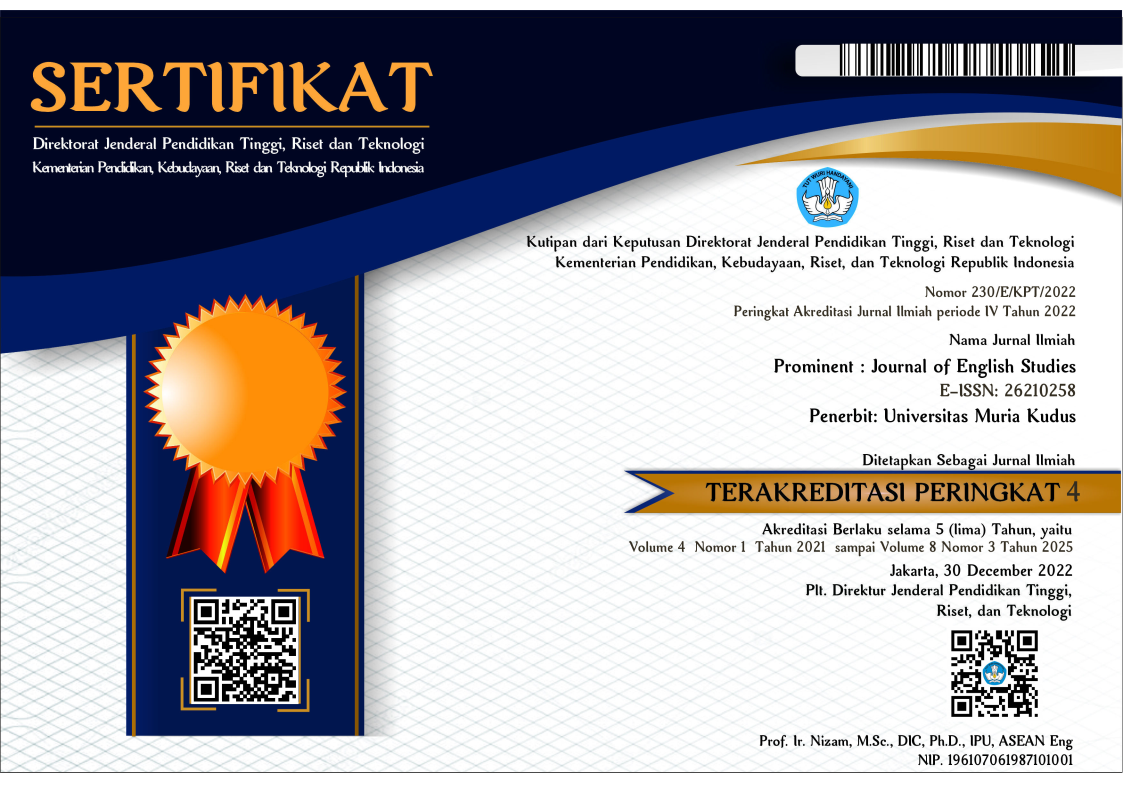INTERCULTURAL ASPECTS IN LANGUAGE EDUCATION
Abstract
Full Text:
PDFReferences
Appiah, A. (2006). Cosmopolitanism: ethics in a world of strangers, 1st edn, W.W. Norton, New York.
Arigatou Foundation.(2008). Learning to Live Together: an intercultural and interfaith programme for ethics education, Arigatou Foundation, Geneva, Switzerland.
Banks, J.A. & Banks, C.A.M. (eds) (2004). Multicultural Education: issues and perspectives, 5th edn, John Wiley & Sons, Hoboken, NJ.
Bluedorn, A.C. (2002). The Human Organization of Time: Temporal Realities and Experience. Stanford, CA: Stanford University Press.
Brisbane Catholic Education.(1999). Cultural literacy across the curriculum. A framework. pp.7–8. Brisbane: Author.
Byram, M. (2008). From Foreign Language Education to Education for Intercultural Citizenship: essays and reflections, Multilingual Matters Ltd, Clevedon, Buffalo, England; Multilingual Matters, Buffalo, NY.
Earley, P. C. & Gibson, C. B. (1998). Taking stock in our progress on individualism-collectivism: 100 years of solidarity and community. Journal of Management, 24: 265-304.
Hall, S. (ed) (1997). Representation: cultural representations and signifying practices, Sage, in association with The Open University, London.
http://www.celt.iastate.edu/international/CulturalDifferences3.html
http://www.australiancurriculum.edu.au/english/general-capabilities
http://www1.gdufs.edu.cn/jwc/bestcourse/kecheng/38/whjiaoan/files/intro.html
Hofstede, G. 2001. Culture's Consequences: International Differences in Work‑related Values (2nd ed). Beverly Hills, CA: Sage.
Janke, T. (2008). 'Indigenous knowledge and intellectual property: negotiating the spaces', The Australian Journal of Indigenous Education, vol. 37, pp. 14–24.
Kalantzis, M. & Cope, B. (2005). Learning by Design, Common Ground Publishing, Melbourne.
Knapp, Karlfried and Seidlhofer, Barbara. (2009). Handbook of Foreign Language Communication and Learning,. Berlin: Walter de Gruyter GmbH & Co. KG, D-10785
Kramsch, C.J. (1998). Language and Culture, Oxford University Press, Oxford.
Liddicoat, A., Lo Bianco, J. & Crozet, C. (eds) (1999)., Striving for the Third Place: intercultural competence through language education, Language Australia, Canberra.
Liddicoat, A., Papademetre, L., Scarino, A. & Kohler, M. (2003). Report on Intercultural Language Learning, Commonwealth of Australia, ACT.
Liddicoat, Anthony J. 2011. Language Teaching and Learning from an Intercultural Perspective. London: Routledge in Eli Hinkel. 2011. Handbook of Research in Second Language Teaching and Learning Volume II. New York: Routledge
Nakata, M. (2007). 'The cultural interface', The Australian Journal of Indigenous Education, vol. 36, pp. 7–14.
Noble, G. & Poynting, S. (2000). 'Multicultural Education and Intercultural Understanding: Ethnicity, Culture and Schooling', in C. Scott and S. Dinham (eds), Teaching in Context, pp. 56–81, Australian Council for Educational Research, Camberwell, Victoria.
Scarino, A., Dellitt, J. & Vale, D. (2007). A Rationale for Language Learning in the 21st Century:www.mltasa.asn.au/rationale.htm (accessed 13March 2014).
Singelis, T.M., Triandis, H.C., Bhawuk, D.P.S., & Gelfand, M. 1995. Horizontal and vertical dimensions of individualism and collectivism: A theoretical and measurement refinement. Cross-Cultural Research, 29: 240-275.
Sleeter, C. & Grant, C. (2003). Making Choices for Multicultural Education: five approaches to race, class, and gender, John Wiley & Sons, New York.
Tannen, Deborah (1990) You Just Don’t Understand: Women and Men in Conversation. New York: Morrow.
Triandis, H.C. 2002a. Motivation to work in cross-cultural perspective. In J.M. Brett & F. Drasgow (eds.) The Psychology of Work: Theoretically Based Empirical Research(pp. 101-118). Mahwah, NJ: Lawrence Erlbaum Associates Publishers.
Triandis, H.C. 2002b. Generic individualism and collectivism. In M.J. Gannon & K.L. Newman (eds.), The Blackwell Handbook of Cross-Cultural Management (pp.16-45). Oxford, U.K.: Blackwell Business.
United Nations Educational, Scientific and Cultural Organization (2006). Guidelines on Intercultural Education, Paris: http://unesdoc.unesco.org (accessed 15 March 2014)
Wiggins, G.P. & McTighe, J. (2005). Understanding by Design, expanded 2nd edn, Pearson/Merrill Prentice Hall, New Jersey.
DOI: https://doi.org/10.24176/pro.v1i1.2491
Refbacks
- There are currently no refbacks.
Prominent Journal of English Studies is licensed under a Creative Commons Attribution-ShareAlike 4.0 International License.
Dedicated to:

in Collaboration with APSPBI:





